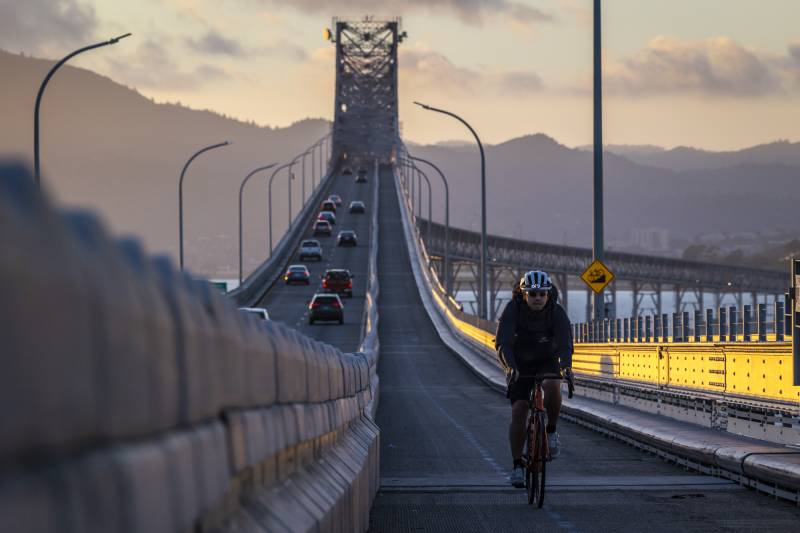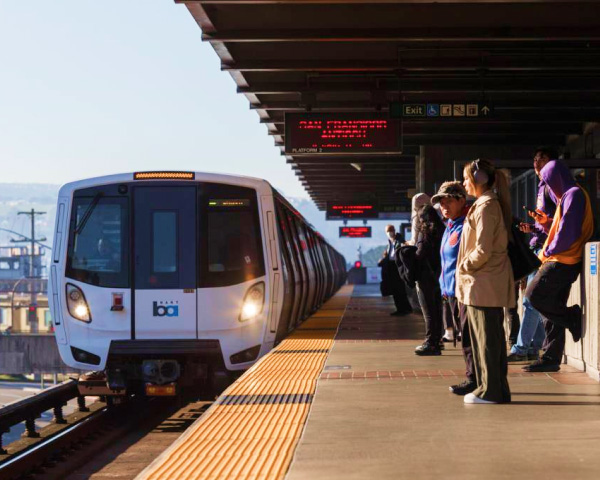Joel Umanzor: [00:01:57] I would say it’s definitely like a gateway to work. A lot of folks that work on the other side of the bridge in Marin County.
Ericka Cruz Guevarra: [00:02:03] Joelle Umanzor is a city reporter for Richmond side.
Joel Umanzor: [00:02:08] It’s a pretty narrow stretch, and it goes pretty long, from Richmond all the way into San Rafael. It’s definitely one of those stretches that is highly used by not just people in Richmond, I think, but the greater East Bay that needs to get over to Marin County. It’s also one of these places where encroaching up on the bridge, traffic can tend to be congested and spill over into Richmond, whether that be on the Castro exit or the Garrard exit.
Ericka Cruz Guevarra: [00:02:35] In 2019, I know a bike path opened on this bridge that’s, as we’ve been describing, is already very sort of narrow. Take us back to when this decision was made. What exactly changed on the bridge and why?
Joel Umanzor: [00:02:52] So in 2019, the California Metropolitan Transit Commission, as well as the Bay Area Toll Authority and Marin County and Contra Costa County all developed this pilot that would open that bike lane on the Richmond-San Rafael Bridge. They were looking to kind of expand accessibility for folks using alternate modes of transportation, non-cars. It was fairly popular around COVID during the time we were all staying at home, stay at home orders, people wanted to get out a little bit more. There’s been a lot of advocates, whether that be local nonprofits, like Rich City Rides, that have promoted a lot more bicycle usage. Richmond Track, which is the folks who advocate for more bike lanes or improved safety for pedestrians and bicyclists. A lot of these organizations, as well as some local municipalities, were in favor of having this bike trail, in an area that is not necessarily known for its accessibility.
Ericka Cruz Guevarra: [00:04:04] This all happened in 2019, the bike lane, but we’re talking about it now because there’s still a really big decision to make, it sounds like, about what to do with this bike lane. Tell us about that.
Joel Umanzor: [00:04:17] Initially when they introduced this, it was a pilot program. It’s on the clock now. It was proposed on the agenda for the Bay Conservation Development Commission, the BCDC, to review and kind of vote on whether this pilot is going to continue or not. The debate currently right now on the bike lane is whether or not to keep it 24-7, as is, to reduce it to just the weekends and keeping the emergency lane open during rush hours and the normal traffic from Monday through Thursday. Or to just scrap it entirely, which is what some of the anti bike lane folks are hoping to do.
Ericka Cruz Guevarra: [00:05:00] Who is making this decision?
Joel Umanzor: [00:05:02] This commission, the BCDC, is kind of comprised of a lot of different municipalities, elected officials. I know we have a couple council members from Richmond that are on that commission. There’s also those in Marin County who are part of that as well. And so I guess when we say who’s making these decisions, this commission is, but it’s a lot different people and it’s a fairly big group. They had this workshop in January to kind of talk about this. And there were just, it was like a four hour meeting and folks were really kind of invested into like how this directly impacts their communities. They had a lot of comments in regards to folks either being really for the bike lane or folks who are more concerned with how cars might be hindered by having this bike lane open 24/7.
Ericka Cruz Guevarra: [00:06:16] Who’s arguing to limit the bike lane?
Joel Umanzor: [00:06:18] There’s a lot of folks in Marin County who are either part of the Bay Area Council, which is like a group of business owners, and then you have folks that work on the other side who might be like, why are we having this lane here when, you know, the traffic is so bad?
Public Commenter: [00:06:31] Our climate change issues are not gonna be solved by a hundred bicycles a day replacing cars. And the need for heavy freight capacity on this bridge is not going away. Open the third lane to full-time traffic.
Joel Umanzor: [00:06:44] For the folks who are anti-bike lane, their biggest concern is traffic and the impacts to traffic getting on the Richmond, from the Richmond side to Moraine.
Public Commenter: [00:06:51] It is an equity issue when minority communities, most of whom make less than the Bay Area median income, concerns in trying to get to work are put on the back burner in favor of the recreational habits of a small group of those earning twice the Bay area median income.
Ericka Cruz Guevarra: [00:07:07] There are other people who really like having the option of being able to bike across the bridge. I mean, who is arguing to keep it open seven days a week?
Joel Umanzor: [00:07:16] Like I mentioned before, I think there’s a strong coalition of different folks, whether that be those involved in these nonprofit organizations that advocate for alternative modes of transportation, or just like folks that just want to have those kind of options.
Public Commenter: [00:07:32] [With the] fire’s still raging in LA, this is a heck of a time to go backwards on active transportation. The path has not had a fair chance.
Joel Umanzor: [00:07:41] Folks mentioned in Richmond that some of these areas that now have access to the bridge are some of the lower income areas, more marginalized communities. With those increased options, it does make it so that folks can know a lot more of their city.
Public Commenter: [00:07:55] So if you create better bike infrastructure, you’ll get more bike users who will then use the bridge more. Folks who are driving are typically upset with traffic. It’s always true. There never is never going to be enough traffic reduction unless there’s nobody on the streets and we’re like kind of like Detroit. So be careful trying to fix congestion at all means over the health and safety of all others. Thank you very much.
Ericka Cruz Guevarra: [00:08:24] I mean, the goal of the pilot program was to sort of answer these questions a little bit to kind of figure out if the bike lane helps or not, and if people are actually using it, right? Like, what do we know about what this bike lane accomplished in the five years that it was operating seven days a week?
Joel Umanzor: [00:08:46] That there was more usage of it, like I said, during those initial COVID days. It accomplished a lot of getting people connected to the greater cycling community, whether that be on the Marin side or on the Contra Costa side. West Contra Costa has a pretty large bicycling community, but I also think that within Richmond itself, that influence is kind of growing over time. And so I would say that it’s definitely helped foster a lot more alternative transportation awareness, you know, speaking from the Richmond side of things.
Ericka Cruz Guevarra: [00:09:18] So it sounds like it made biking more of a reasonable alternative. But then, I mean, you alluded to some of the arguments on the other side of the lane increasing traffic or increasing emissions. What do we know about that?
Joel Umanzor: [00:09:35] You know, on the bridge itself, incidents of like a collision or side-swiping or people, you know, getting into a minor collision doesn’t necessarily happen as often as folks might think it does with the bike lane. So that also is a factor when this commission is kind of reviewing how much the bike lane is affecting like, let’s say, emergency services to get to like an accident.
Ericka Cruz Guevarra: [00:10:00] A study by UC Berkeley researchers hired to analyze the bike path’s effect on traffic found that compared to average conditions between 2015 and 2018, the bike lane has not had a major impact on congestion. Peak times across the bridge have increased by just less than one minute. The study also found that the bike lanes hasn’t had a big impact on vehicle emissions. Safety or traffic accidents. Still, people against the bike lane point out that there are way more people who use cars than bikes to cross the bridge overall. And the fate of the third lane remains an open question.
Ericka Cruz Guevarra: [00:10:52] Well, where do things stand now, Joel? I mean, what’s the timeline here? When can we expect a decision to be made on the bike lane?
Joel Umanzor: [00:11:00] We’re waiting till July to see if this item is going to be put back on the agenda. We’re on the road to getting there but it definitely is one of those things that we’re a little further away than one might think. I don’t see a situation where, you know, in my opinion this thing is scrapped entirely. I think there’s a large enough contingent of folks that are really pushing for it that if we do see anything adjusted it’ll probably just be adjusted, you know for scheduling-wise, not for if it exists or not.
Ericka Cruz Guevarra: [00:11:29] And I mean, this is a very specific question that we’re asking. I mean do we keep the bike lane on the bridge or not? But it also feels like just a slice of this larger kind of debate that we are having in the Bay Area as you’ve kind of alluded to earlier. I mean what do you think makes this a Bay Area story or what do think there is to learn from this about life in the bay area right now?
Joel Umanzor: [00:11:54] I think it just shows the ever-evolving, I guess, struggle between folks that are really trying to get away from car dependency. You know, Richmond is an interesting place in that we have Chevron right there. So there’s an understanding of how oil dependency has kind of shaped policies in the city. We have this kind of debate in the Bay Area about alternative modes of transportation, not being a car-centric culture. But at the end of the day, I think it just kind of boils down to that car versus non-car debate that we’ve seen in the bay area, not just in Richmond and San failed by I think in the greater in the Greater Bay Area.
Ericka Cruz Guevarra: [00:12:36] Joelle, thank you so much for sharing your reporting with us on the show. I appreciate it.
Joel Umanzor: [00:12:40] Yeah, for sure. Thank you for having me.

